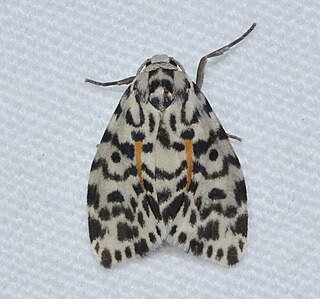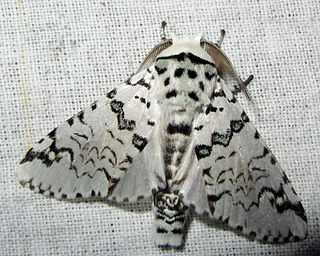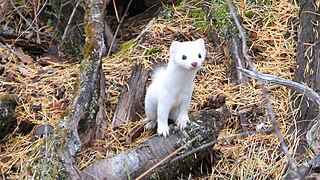
The stoat, also known as the Eurasian ermine, Beringian ermine and ermine, is a mustelid native to Eurasia and the northern portions of North America. Because of its wide circumpolar distribution, it is listed as Least Concern on the IUCN Red List. It is distinct from the long-tailed weasel, also known as the "masked ermine", or "big stoat"; the two species are visually similar, especially the black tail tip.

Notodontidae is a family of moths with approximately 3,800 known species. The family was described by James Francis Stephens in 1829. Moths of this family are found in all parts of the world, but they are most concentrated in tropical areas, especially in the New World.

Notodontinae is the nominate subfamily of the moth family Notodontidae. The Ptilodoninae are sometimes merged herein. The genus list is preliminary, as not all Notodontidae have been assigned to subfamilies yet.

Cerura vinula, the puss moth, is a lepidopteran from the family Notodontidae. The species was first described by Carl Linnaeus in his 1758 10th edition of Systema Naturae.

Clemensia is a genus of moths in the family Erebidae. The genus was described by Packard in 1864.

Acronicta strigosa, the marsh dagger, is a moth of the family Noctuidae. It is distributed through most of Europe, east to the Caucasus, northern China, Korea and Japan.
Ermine may refer to three species of mustelid in the genus Mustela:

Tecmessa scitiscripta, the black-etched prominent, is a moth of the family Notodontidae. It is found from Quebec west to eastern Alberta, south to Florida and Texas, and was formerly placed in the genus Cerura, which is now restricted to the Old World.

Cerura liturata is a moth of the family Notodontidae described by Francis Walker in 1855. It is found from the Oriental tropics of India, Sri Lanka to Sundaland.

Cerura is a genus of moths of the family Notodontidae described by Franz von Paula Schrank in 1802.

Cerura menciana is a moth of the family Notodontidae. It is found in Japan, Korea, China, Burma and Taiwan.
Clemensia erminea is a moth of the family Erebidae first described by William Schaus in 1896. It is found in the Brazilian states of São Paulo and Paraná.
Ditrigona quinaria is a moth in the family Drepanidae. It was described by Frederic Moore in 1867. It is found in China, Tibet and India.
Tecmessa is a New World genus of moths of the family Notodontidae described by Hermann Burmeister in 1878, and historically confused with the Old World genus Cerura.

The Haida ermine is a mustelid species endemic to a few islands off the Pacific Northwest of North America, namely Haida Gwaii in Canada and the southern Alexander Archipelago in the U.S. state of Alaska.

The American ermine or American stoat is a species of mustelid native to most of North America.
This page is based on this
Wikipedia article Text is available under the
CC BY-SA 4.0 license; additional terms may apply.
Images, videos and audio are available under their respective licenses.













